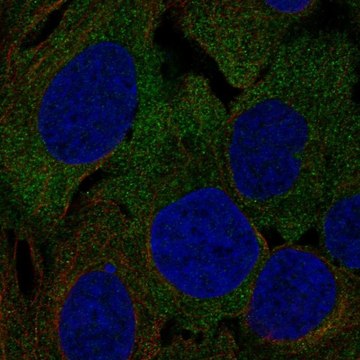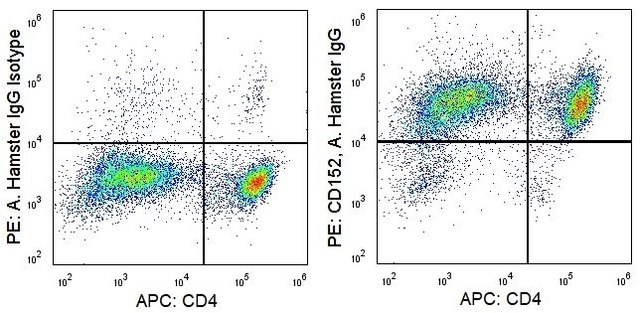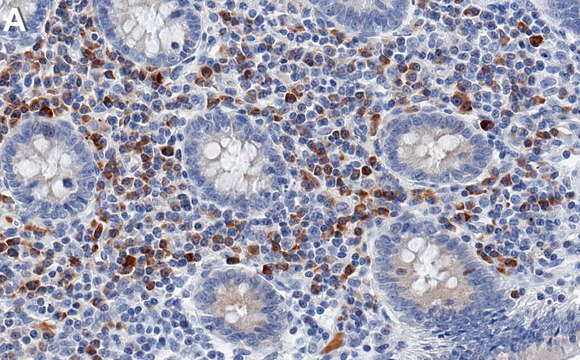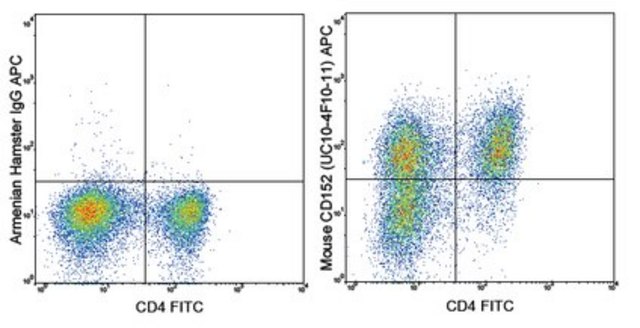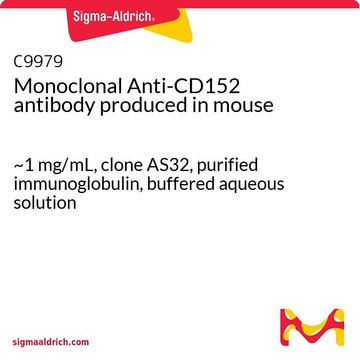04-963
Anti-CTLA4 (CD152) Antibody, clone 9H10
clone 9H10, from hamster
Synonym(s):
CD152 antigen, Cytotoxic T-lymphocyte-associated antigen 4, celiac disease 3, cytotoxic T-lymphocyte-associated protein 4, cytotoxic T-lymphocyte-associated serine esterase-4, ligand and transmembrane spliced cytotoxic T lymphocyte associated antigen 4
About This Item
Recommended Products
biological source
hamster
Quality Level
antibody form
purified immunoglobulin
antibody product type
primary antibodies
clone
9H10, monoclonal
species reactivity
mouse
technique(s)
flow cytometry: suitable
immunoprecipitation (IP): suitable
western blot: suitable
isotype
IgG
NCBI accession no.
UniProt accession no.
shipped in
wet ice
target post-translational modification
unmodified
Gene Information
human ... CD28(940) , ICOS(29851)
Related Categories
General description
Specificity
Immunogen
Application
FACS analysis of ConA (24 hours) stimulated BALB/C splenocytes for surface expression of CTLA-4 (CD152). Cells were stained with 10 ug of biotin-labeled hamster anti-CTLA-4 ,clone 9H10 (open histogram) or with PE-Sav secondary antibody alone (histogram, Figure B). Note the distinct signal difference between the control (dark control histogram) and test (clear histogram).
Immunoprecipitation: Clone 9H10 is widely used for immunoprecipitaiton of CTLA-4; recommended lysis buffers include 1% NP40; 0.5% triton X-100 with proteinase inhibitors; 1-5 µg of 9H10 is added to 300-500 µL of whole cell lysate or cell membrane protein preparations (250-500 mg/mL totall protein) and incubated 3-6 hours at 4°C, followed by capture with protein G beads following standard immunoprecipitation methods (Zhang, Y., et al., 1997).
Inflammation & Immunology
Transcription Factors
Inflammation & Autoimmune Mechanisms
Quality
Western Blot Analysis: 1 µg/mL of a biotinylated version of this antibody detected CTLA4 in 10 µg of mouse spleen lysate.
THIS ANTIBODY IS NO BIOTINYLATED.
Target description
Physical form
Storage and Stability
Analysis Note
Mouse spleen cell lysate
Other Notes
Disclaimer
Not finding the right product?
Try our Product Selector Tool.
Storage Class Code
12 - Non Combustible Liquids
WGK
WGK 1
Flash Point(F)
Not applicable
Flash Point(C)
Not applicable
Certificates of Analysis (COA)
Search for Certificates of Analysis (COA) by entering the products Lot/Batch Number. Lot and Batch Numbers can be found on a product’s label following the words ‘Lot’ or ‘Batch’.
Already Own This Product?
Find documentation for the products that you have recently purchased in the Document Library.
Our team of scientists has experience in all areas of research including Life Science, Material Science, Chemical Synthesis, Chromatography, Analytical and many others.
Contact Technical Service